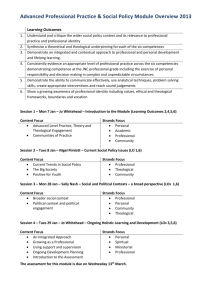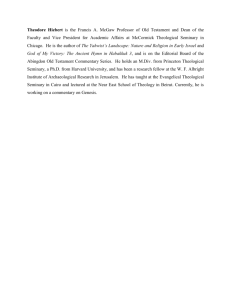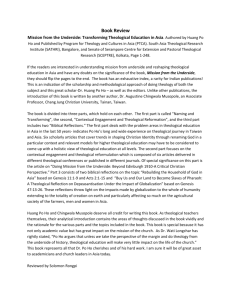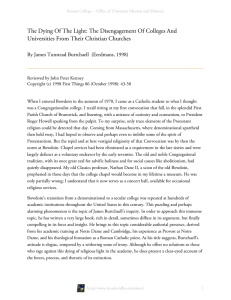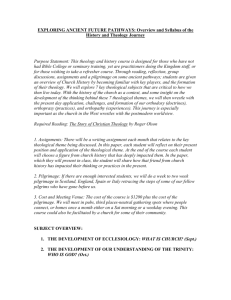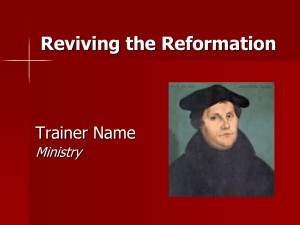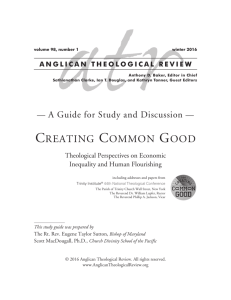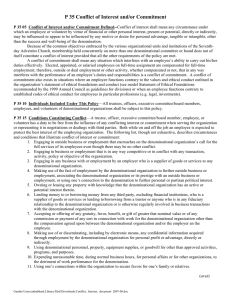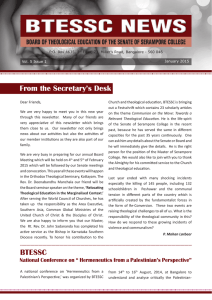Response - The Wesley Center Online
advertisement
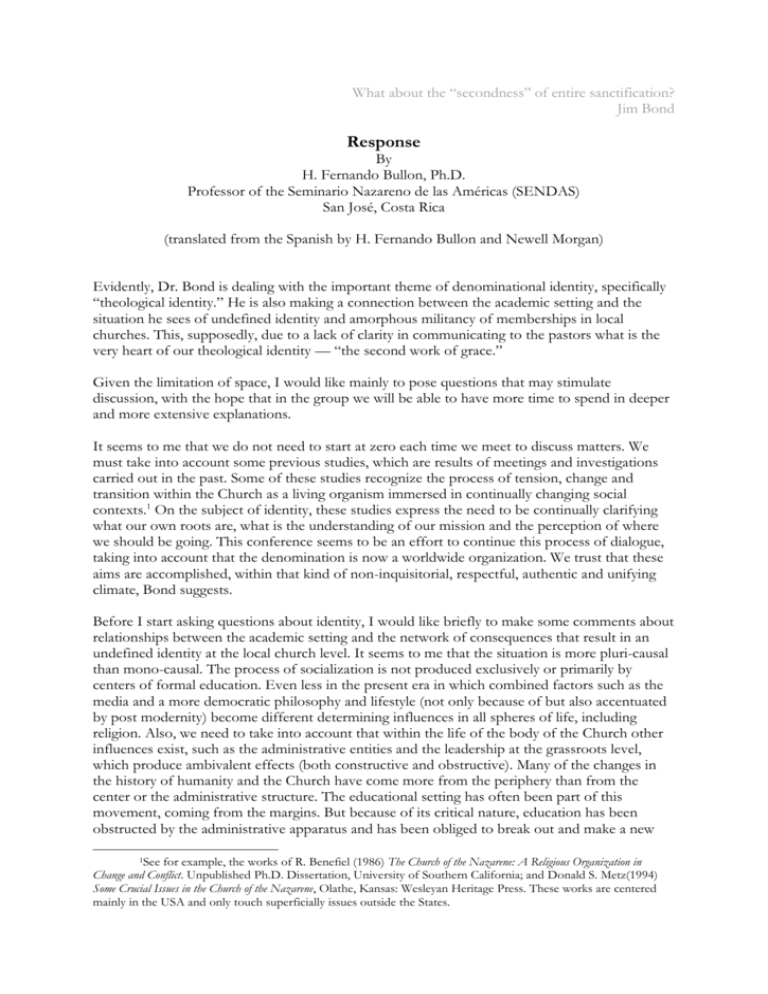
What about the “secondness” of entire sanctification? Jim Bond Response By H. Fernando Bullon, Ph.D. Professor of the Seminario Nazareno de las Américas (SENDAS) San José, Costa Rica (translated from the Spanish by H. Fernando Bullon and Newell Morgan) Evidently, Dr. Bond is dealing with the important theme of denominational identity, specifically “theological identity.” He is also making a connection between the academic setting and the situation he sees of undefined identity and amorphous militancy of memberships in local churches. This, supposedly, due to a lack of clarity in communicating to the pastors what is the very heart of our theological identity — “the second work of grace.” Given the limitation of space, I would like mainly to pose questions that may stimulate discussion, with the hope that in the group we will be able to have more time to spend in deeper and more extensive explanations. It seems to me that we do not need to start at zero each time we meet to discuss matters. We must take into account some previous studies, which are results of meetings and investigations carried out in the past. Some of these studies recognize the process of tension, change and transition within the Church as a living organism immersed in continually changing social contexts.1 On the subject of identity, these studies express the need to be continually clarifying what our own roots are, what is the understanding of our mission and the perception of where we should be going. This conference seems to be an effort to continue this process of dialogue, taking into account that the denomination is now a worldwide organization. We trust that these aims are accomplished, within that kind of non-inquisitorial, respectful, authentic and unifying climate, Bond suggests. Before I start asking questions about identity, I would like briefly to make some comments about relationships between the academic setting and the network of consequences that result in an undefined identity at the local church level. It seems to me that the situation is more pluri-causal than mono-causal. The process of socialization is not produced exclusively or primarily by centers of formal education. Even less in the present era in which combined factors such as the media and a more democratic philosophy and lifestyle (not only because of but also accentuated by post modernity) become different determining influences in all spheres of life, including religion. Also, we need to take into account that within the life of the body of the Church other influences exist, such as the administrative entities and the leadership at the grassroots level, which produce ambivalent effects (both constructive and obstructive). Many of the changes in the history of humanity and the Church have come more from the periphery than from the center or the administrative structure. The educational setting has often been part of this movement, coming from the margins. But because of its critical nature, education has been obstructed by the administrative apparatus and has been obliged to break out and make a new 1See for example, the works of R. Benefiel (1986) The Church of the Nazarene: A Religious Organization in Change and Conflict. Unpublished Ph.D. Dissertation, University of Southern California; and Donald S. Metz(1994) Some Crucial Issues in the Church of the Nazarene, Olathe, Kansas: Wesleyan Heritage Press. These works are centered mainly in the USA and only touch superficially issues outside the States. start. Paradoxically, this is the case and itinerary of our particular theological identity: The Protestant Reformation (clearly inspired by Luther from an educationalsetting), and the Wesleyan revival, and the birth of our denomination itself (as expressions from the grass root leadership). Identity and the denominational context In worldwide institutions with a long historical trajectory like the church, how are new generations to be incorporated into the perception, re-definition, and, consequently, affirmation and appropriation of the identity as “tradition” (historic roots)? What role do historical and cultural factors play in the definition of the roots? What incidence should the change in proportion of a denomination in socio-geographical terms play in the participation of the definitions of what is group identity? Given that all theological expression is a historical and socially situated product, what are the risks of reductionism and ideologization2 of religious experience when defining the identity of the group on the basis of personal experience and particular histories? Yes, we must have the Scriptures, tradition, and experience for an adequate hermeneutics about this issue of identity; but we also need reason. Is it possible that advances in the sociology of knowledge could help us understand better the process of knowledge production (including theological knowledge)? Could we come to the formulation of the famous “restrictive clause” about identity with a more carefully meditated ecclesiology and a more informed posture on the issue of which dynamics enter into the definition of identity of human groups? Identity, the holiness movement and the evangelical church In institutions, such as a denominational church that admits to being part of the universal Church, Which elements should be chosen as essential, not secondary, to define identity as crucial for its life, mission, and projection (future or destiny)? How do other Holiness groups, and other sectors of the Church see us?3 What is our objective perception of the demographic weight we represent in these sectors? Within the dynamics of communion and unity proper of the body of Christ, are we starting from a humble position and do we allow others the same prerogatives that we demand for ourselves to “permeate” them with our “theological treasure”? Evidently, the point of this second set of questions has to do with subjectivity and selfabsorbedness, which could cause a loss of the sense of reality and of importance in the nature and mission of the Church. This is especially so when this is expressed increasingly in a division sub species. This rests on “doctrinal formulae” and a messianic complex that put others in second place, giving little attention to exercising a solid and integrated identity, which is not expressed in a dogmatic subjective capsule, but in an efficacy that transforms history. Understanding objectively the demands of the human situation of our countries, there is no other way but to consider a paradigm of identity and action that is more inclusive of the body of Christ.4 2Here, ideologization means a false consciousness, an affirmation that doesn’t correspond to real situations and, as a result, alienating and disorientating human behavior and impeding a correct development on the basis of truth. 3See e.g., the books of J. I. Packer (1992) Rediscovering Holiness, Servant Publications (especially Chapter 4: “A Panoramic Vision of Holiness”), and John R. W. Stott (1999) Evangelical Truth: A Personal Plea for Unity, Integrity and Faithfulness, Leicester, UK: IVP. 4It is advisable to review statistics about the proportion of evangelicals in the majority of our countries (usually true minorities) and see what proportions we represent within them.
